As the second month that has been most noted in bringing forth conversations around mindful drinking comes to a close1 it’s a great time to talk about a trajectory and fortifying roadmap to the glorious grape juice that is wine.
As you may have read, the time for wine is waning according to various reports, which is concerning given the in vino veritas2 connection to telling stories of people, place, and possibilities. The swirling around wine consumption being down, rivals that of an enthusiast taste testing old Burgundy at a table with his banker bros after seeing the SOMM documentary. From generational differences to health and financial concerns the dire picture being painted for folks in and beyond the beverage industry is that the wine business is being drained faster than rosé porch pounders on a summer afternoon - which is maybe more of a six pack, than the full case.
Wine is a $330 billion global business and estimated to cross $400 by 20273, and there is much nuance, as noted in the 2024 BMO Wine Market Report, behind the numbers we see from those with enormous financial skin in the game, serving up stories that the once prized pressed juice is now going from stainless steel tanks to actually tanking. Over the last three years we’ve read of vineyards being ripped up across new and old world regions while still getting a trickle of stories - that the sky is not actually falling.
Wine Enthusiast: Grim Reports Have the Wine Industry in Knots. But Should We Just Calm Down? - Kate Dingwall
The Morning Claret: Is the Future of Wine Really in Trouble? - Simon J Woolf
Wine is Confusing: Young People Aren't Drinking Wine—And This Headline Isn't Landing - Kara Daly
Is wine in a state of transition? Absolutely. Are the big names like E&J Gallo with even bigger dollars to lose feeling the pain from the bottom of the barrel no longer being guzzled at bottomless mimosa brunches? You bet. And while there are many small businesses and folks being impacted, which aren’t nearly as big as the Gallo Goliath, it’s not the whole story - it never is with the selling of doom and gloom to chicken littles, which are the consumers and beverage buyers.
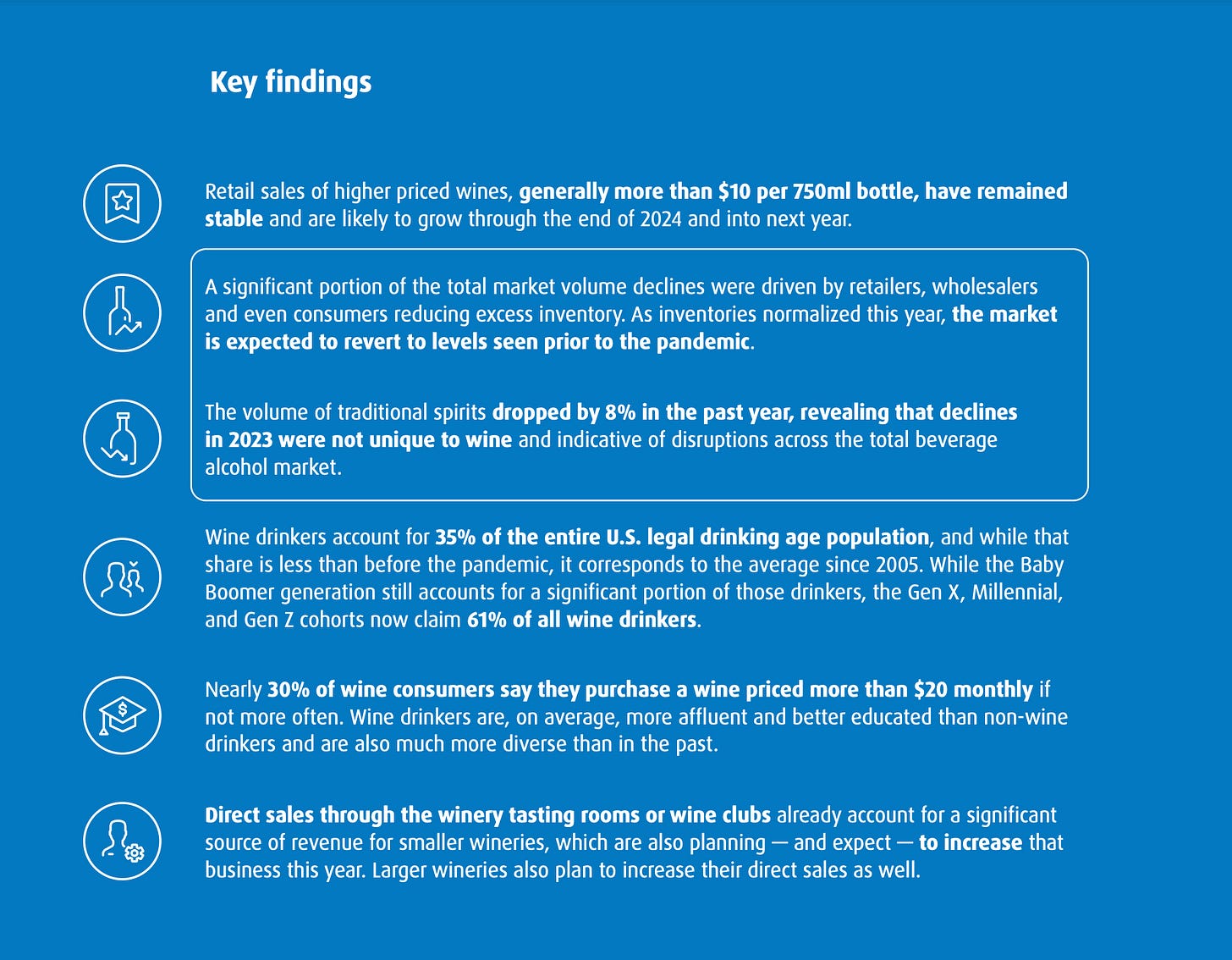
What cannot be disputed is that when a billion dollar industry takes even a small hit in sales, the numbers look frightening - which is happening, especially for some U.S. based wines. Yet, with all the fear and town crier megaphone moments (often marketing board backed), far too many in our beverage worlds aren’t ready to meet current wine drinkers and a new generation where they’re at today, while seemingly digging their heels in, on old ways. And it makes sense, from the late 80s and well into the aughts wine had an incredible heyday - my own career benefitted from it greatly, so I’m not looking a gift horse in the mouth when I propose the following, rather it’s because I want to see wine thrive at those nostalgic levels, through a full looking glass. It’s time for the wine industry to welcome, implement, and champion dealcoholized wine alongside the alcoholic versions in portfolios, as a way to bring more financial sustainability to the entire ecosystem - wineries, importers, distributors, retail and on-premise.
Let me say as a former wine bar owner and someone that’s spent over two decades dedicated to studying, teaching, buying, and selling wine; traveling across the globe to better understand the economics and stories of folks growing grapes, bottling juice and getting it into guest’s glasses - I fully understand the enormous amount of money needed to take on the dealcoholized suggestion. It’s not being served here, lightly. I’ve also run into a number of folks in the wine industry decrying the sustainability of dealcoholizing wine4 - for now, we’re going to leave that conversation for another time because as stated, we are talking about a highly nuanced agricultural product - and readers only have so much stamina to sip on this type of sizzurp.
Exploration Evangelization
Wine folks have a knack for evangelizing exploration, while easily falling into whatever elite dogma of the day is being poured into our glasses. We say we’re cutting edge and then follow the “leaders” - which are almost always the businesses with the most wealth, generational and otherwise. So while fear mongering has us all shaking in our vineyard boots that the non-alcoholic world is coming for our placements5 what we’re missing is this - dealcoholized wine makes the pie bigger for our industry in today’s marketplace. Maybe the fright night fangs are coming out because those who still consume alcohol regularly are buzzed on an all or nothing mindset, but many of the folks drinking less alcohol are still drinking and not having the option to imbibe the diet coke version of their favorite red wine is only hurting that business and our industry, while consumers move to zero proof cocktails as their often, only option.
Antidote to Wine Woes Back by the Numbers
I know, I know - no one said there would be math in our wine. But if we’re going to make the case for wineries and winemakers to embrace the non-alcoholic favor, we’ve got to show more than twelve bottles of dealcoholized wine we like to drink in January.
IWSR is a well known leader in global drinks data and insight amongst the beverage industry. The first time I had the chance to deep dive on their expertise was at the start of 2023, when they came out with the staggering numbers that the no and low-alcohol category surpassed 11 billion dollars in 2022, with exponential growth expected to increase by at least a third in 2026. This is old news to beverage industry folks, right? Sure, but their numbers in 2024 are what help paint the picture of where wine and non-alcoholic sectors converge for future opportunities of longevity.
In their ‘8 Key Trends Set to Shape Beverage Alcohol in 2024’, IWSR gets into the state of the state for Premiumisation, E-commerce, Ready-to-Drink (RTD), Beer and more - with two categories of note: the decline in wine and growth in the no-alcohol market. As many reports have shown, beyond the one shared from IWSR, wine as a category is ten percent smaller then it was in 2019 - but of note from the IWSR trends “Wine dominates the global low-alcohol space, expanding strongly off a small base to record volume of +8% in 2023, with a forecast showing a volume growth of +6% through 2027”. 6
NCSolutions, which was acquired by data and demand giant Circana over the summer, did a solid snapshot of zero proof data based on January 2023 and 2024, that further drives home the connective opportunities between wine and dealcoholization - which makes sense given their focus on obtaining advertising clients in the CPG sectors. The stand out in terms of the dealcoholized wine conversation are in the following infographics, based on NCSolutions surveys.
NCSolutions explained further why folks rated mocktails the highest among beverages to try “The main reasons people are drawn to these types of alcohol-free drinks are because they want to see what it tastes like, consider it a healthier alternative to alcohol, and like the look of it.” - tells me that’s likely an on-premise7 situation versus the alcohol purchases being grocery. So there may be some correlation, rather than causation between the numbers. Yet the foundation remains strong for the wine world to capitalize in dealcoholization to balance a continued fall is sales because it’s still the most popular alcohol purchase8 according to the NCSolutions survey. Additionally - if health is a concern for folks who still want to imbibe, dealcoholized wine gives all the benefits we’ve been hearing about for years with resveratrol still being in tact, without the negative alcohol impact.
Now, I understand NCSolutions is going to show data to help them hook clients, same - maybe less so for IWSR. But a quick search across the internet and the changing landscape of premium wine selections getting into the dealcoholized game easily showcases why now is not the time to sleep on meeting the consumers where they’re at in consuming, while getting restaurants on board as a key tipping point for embracing wine two ways.
Restaurants are the Dealcoholized Wine Domino
At one time, pre-pandemic, Chicago was pushing the envelope when it came to the spirit free movement. Julia Momose was doing extraordinary work in the category and led the charge in encouraging folks to ditch the word mocktail, as she wanted to see more respect given to the art and craft going into the glass at the time. In 2015, given the evolution of programs in Chicago - we incorporated seasonal rotating selections of four spirit free cocktails into our wine bar, which not only brought more to the bottom line but led to multiple business opportunities as well. What’s interesting or maybe concerning is that four zero proof cocktails at most restaurant these days would be a lot, despite the incredible evolution of the zero proof sector. We’re lucky if we get two to three, with many “zero proof sections” being rounded out by soft drinks, coffee, tea and bottled water9. While any options are better than none, as it pertains to this conversation there are rarely any dealcoholized wines accompanying their cocktail counterparts, if there are it’s usually one - which is a start, while still leaving an enormous amount of inclusive opportunities on the table. I understand the reasons we’ve potentially gone backwards since the before covid times - staffing, inflation, lack of time and resources - especially for training around items owners and beverage directors may at first not see as revenue drivers, and that’s where dealcoholized wine in bottles as well as ready to drink cans10 - can come into play.
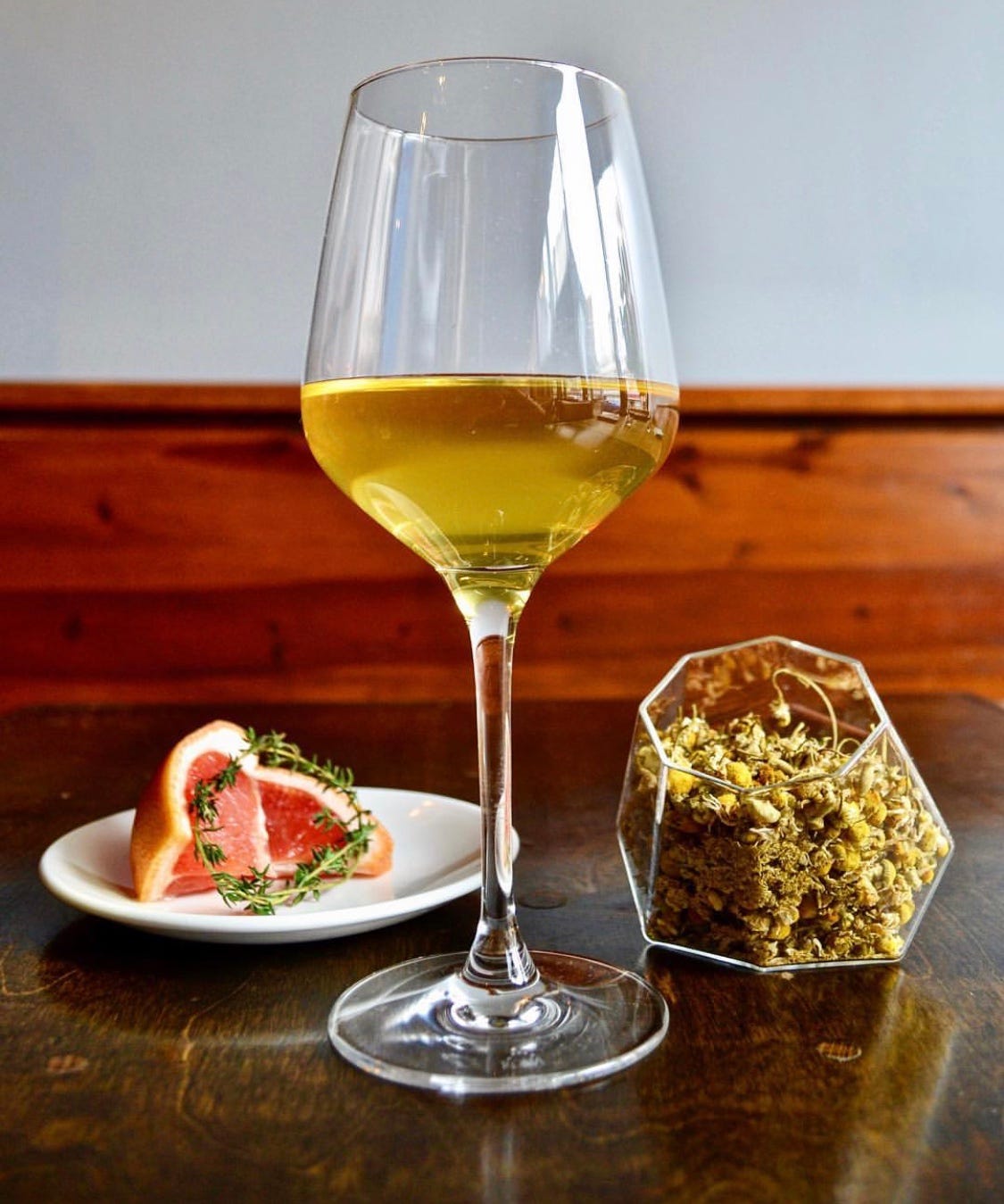
Zero proof cocktails are great, and necessary for a robust beverage program these days - yet, there’s a gamble when it comes to only having cocktails available. The guest may not like or have an allergy to the ingredients being used; if either are the case and when the guest chooses not to imbibe - the sale, hospitality and elevated experience are all lost. Dealcoholized wine gives guests an option with which they’re already familiar - where they can substitute with ease and enjoyment. An example would be a sparkling rosé that resembles Cava, but it’s dealcoholized. It also allows for beverage programs to be more inclusive, a topic we’ve seemed to drift farther away from since 2020.
If you’ve been in the beverage industry for any length of time you’ll know that while it’s great to have wines poured by acclaimed restaurants and neighborhood gems alike - retail is where beverage selling folks make money. While that is true, in addition to wines at restaurants and bars adding revenue for the entire ecosystem - they are also an incredible word of mouth marketing arm and endorsement for guests to then go buy what they’ve enjoyed from a staff recommendation, at their local shop. As retail continues to dominate the zero proof space, restaurants who include wine in their beverage programs have an enormous opportunity to add revenue and loyal guests with the dealcoholized equivalents.
Yes, More Math …
As an operator look at your wine and zero proof sales, if you have any of either and don’t offer dealcoholized wine by the glass then we’re talking about more money being left on the table. Guests who like wine want to drink it and anecdotally we all know folks rarely drink one glass - the same is true for dealcoholized wine. As someone who’s spent much of my adult drinking life immersed in wine, and has taken a break from it for almost eleven months I can attest to always having two glasses of the dealcoholized stuff when available or a zero proof cocktail and then a glass of wine, versus only one cocktail when a wine alternative isn’t available.
The average glass of dealcoholized wine is $12, which by anecdotal standards is going to result in $24 on the check, because the guest will have two glasses. If only one guest order those two glasses at a restaurant, each of the five days a week it’s open and we take one month out of the calendar to account for holidays - that’s $5280 a year in revenue - from one guest! If that glass of wine is alongside an optimized zero proof program (cocktails, beer, wine) the revenue brought to the bottomline is going to make the difference in year over year sales and building guest loyalty that will easily cover the cost of goods.
My changed relationship with alcohol has given me a clearer vision into a future that is brighter for an industry I love, because terroir and skilled wine making can still be tasted in a glass of dealcoholized wine and it’s far more enjoyable to sip on than an ultimatum of whether or not wine is an option for those being sans booze.
As Sober October winds down, restaurants may think this is the time to file away the above revenue opportunities until Dry January, but now is actually the time to make beverage programs more robust with dealcoholized wine for various reasons:
Staff Education: get staff ready to generate more sales in January by being versed in dealcoholized wine substitutes - that can also boost check average above busy season.
Holiday Buzz: we know folks over imbibe during the holidays, and having non-alcoholic options for zebra striping are a great way to pace folks without it feeling like punishment. Also, folks not drinking will absolutely scour your menus to see if you offer alcoholic bubbly for celebrations and choose spots that will allow them to participate in festivities without being othered.
Press Pitches: whether you’re an in-house marketing spot or have folks pitching for you, the press works on stories well in advance - make sure you’re top of mind with writers before January when a lot of folks will be scrambling to get into the inboxes when sales take the usual first of year slump.
Timing
As with most editorial essays, the timing here is purposeful - at the end of Sober October as wineries are coming off of fall harvest in Northern Hemisphere vineyards and restaurants gear up for the holidays. While in the editing process as she often does, Serendipity showed up with a newsletter from the outstanding author, educator, and award-winning bartender Derek Brown.
The diligence and storytelling presented by Brown in the piece, ‘The End of Wine’ is top notch, and he has poignant points and quotes from folks throughout the beverage industry who are not afraid to take on this new exploration of two ways to wine. He also brings up another timely aspect from this month and the creation of ‘Come Over October’, by Karen McNeil and a few of her wine marketing counterparts, which was cutely quipped COO and rose as an answer to less glasses being consumed in dry focused months.
As with most Gen X and Y folks who have a career in wine, my education began with McNeil’s ‘Wine Bible’ so there is deep respect for her profound impact on the wine industry as a whole. However, when McNeil shared the post about Dry January, which Brown sites in his piece, I was incredibly disappointed and took to the internet in saying so - as did a lot of other beverage professionals. As shown in the numbers, there is an enormous opportunity to embrace dealcoholized wine rather than villainize it, to help our industry. Refusing to champion wine in a different form is an absolute miss from someone that claims they care about the longevity of our business, while seemingly only wanting to do so on established and very profitable terms.
Yes, COO mentioned including dealcoholized options, but like most wine guilds treated Spain in the early aughts - it was in passing and clearly not with serious intent. Case in point - one look at their Instagram feed and you’ll notice there are no features of dealcoholized wine, while easily spotting it’s a marketing campaign - even targeted at the political level, to save alcohol - in the odyssean vehicle of wine. If this were a strategy to save wine, rather than a tactic to preserve the entrenched streams of revenue - the dealcoholized versions wouldn’t be posed as the enemy - they would be included. A timely example of such, can be found in the release of Seth Godin’s new book, This Is Strategy: Make Better Plans, who recently sat down with Rachel Karten for a Link in Bio conversation.
‘A strategy is simple, easy to talk about and hard to stick with. A strategy works with systems and time, and dances with the people we seek to serve. Tactics, on the other hand, change often, can be secret and are about what’s right here and right now.’
COO’s tagline of ‘to toast together’ is at the heart and ethos of having non-alcoholic options for folks to come together, while not be othered. Hopefully it’s only the beginning of COO’s opportunity for a longtime legend in wine to embrace it two ways.
As the wine industry continues to find its footing in new, ever changing landscapes - dealcoholized wine in a portfolio is similar to the white to its red wine counterpart, the diet coke to original recipe, and decaf to fully leaded coffee - it’s an opportunity to stay connected with folks that either have changing needs and tastes or haven’t found their way to glorious glasses - yet. While dealcoholizing costs are something worth exploring in another conversation - wine folks are already resourceful in their ways of utilizing custom crush facilities and wine co-ops to alleviate the expenses that come with production. The same philosophies can be applied to dealcoholization, and how we get there is by starting thoughtful, inclusive dialogue around tables with full hearts and glasses - no matter the choice of what we put in them.
If we are truly going to come together in the crusade to strengthen the wine industry - it comes through change, adaptability and an open mindedness to allow our cups to runneth over, with wine two ways.
Interested in implementing dealcoholized wine into your menus? Looking for training to ensure your team is up to speed on how to bring more revenue in for holiday season AND Dry January? Robust and evolving beverage programs (alcohol and zero proof) are one of our areas of expertise at Aldea Hospitality. Our community reaps the benefits of over two decades of experience in beverage direction, menu design, and data driven results. ‘Say Hello’ - we’d love to chat.
Dry January being the big month for zero proof economics.
In Vino Veritas = In Wine, There is Truth
A lot of folks want to talk about the sustainability issues with dealcoholizing - but as one importer so deftly said to me in a recent conversation - if people cared about sustainability in wine, Bordeaux would be out of business.
The beverage world is known for being cutthroat in “stealing” placements and I’m starting to see similar from non-alcoholic brands. Yes, it’s business - but we have a real opportunity to keep a rising tides mentality in a business that’s helping folks to keep imbibing while prioritizing their health.
The 8 Key Trends from IWSR is available via an ebook, with the exchange of business email and information. Get yours here.
For non-beverage industry folks: on premise is restaurants versus grocery being classified as retail.
Not all wine sales are down, plenty of categories are doing well - and while this article focuses on American wine, it’s worth noting the sky isn’t falling everywhere. American Wine Crisis - SevenFiftyDaily.
Grouping zero proof with soft drinks is miss, and doesn’t do pricing comparisons any favors. Menu design is a big part of the work we do at Aldea Hospitality - because maximizing beverage revenue has changed drastically in the last five years.
Less spoilage for open bottles that may not sell, while an on premise team gets acclimated to selling with terms like substituters, pacers and zebra striping make a great case for a 375ml can of dealcoholized wine.


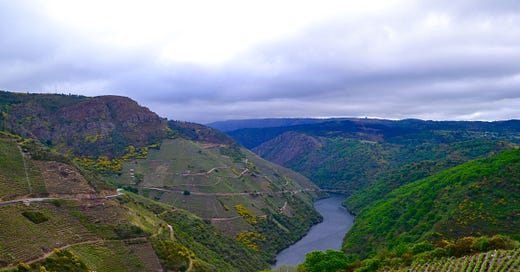



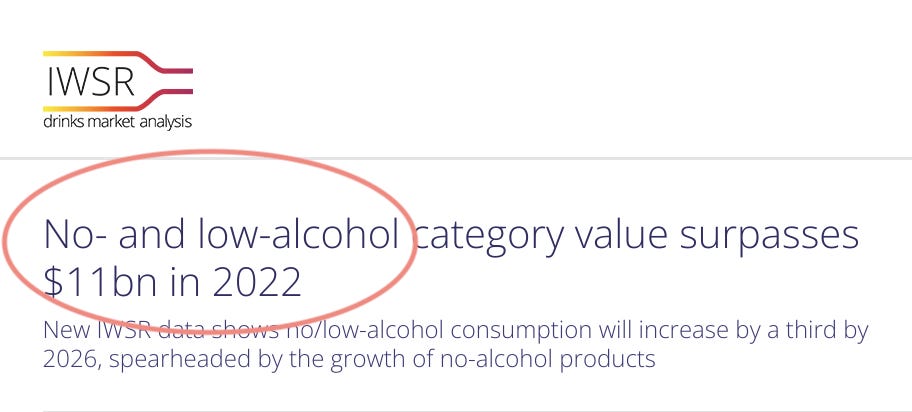
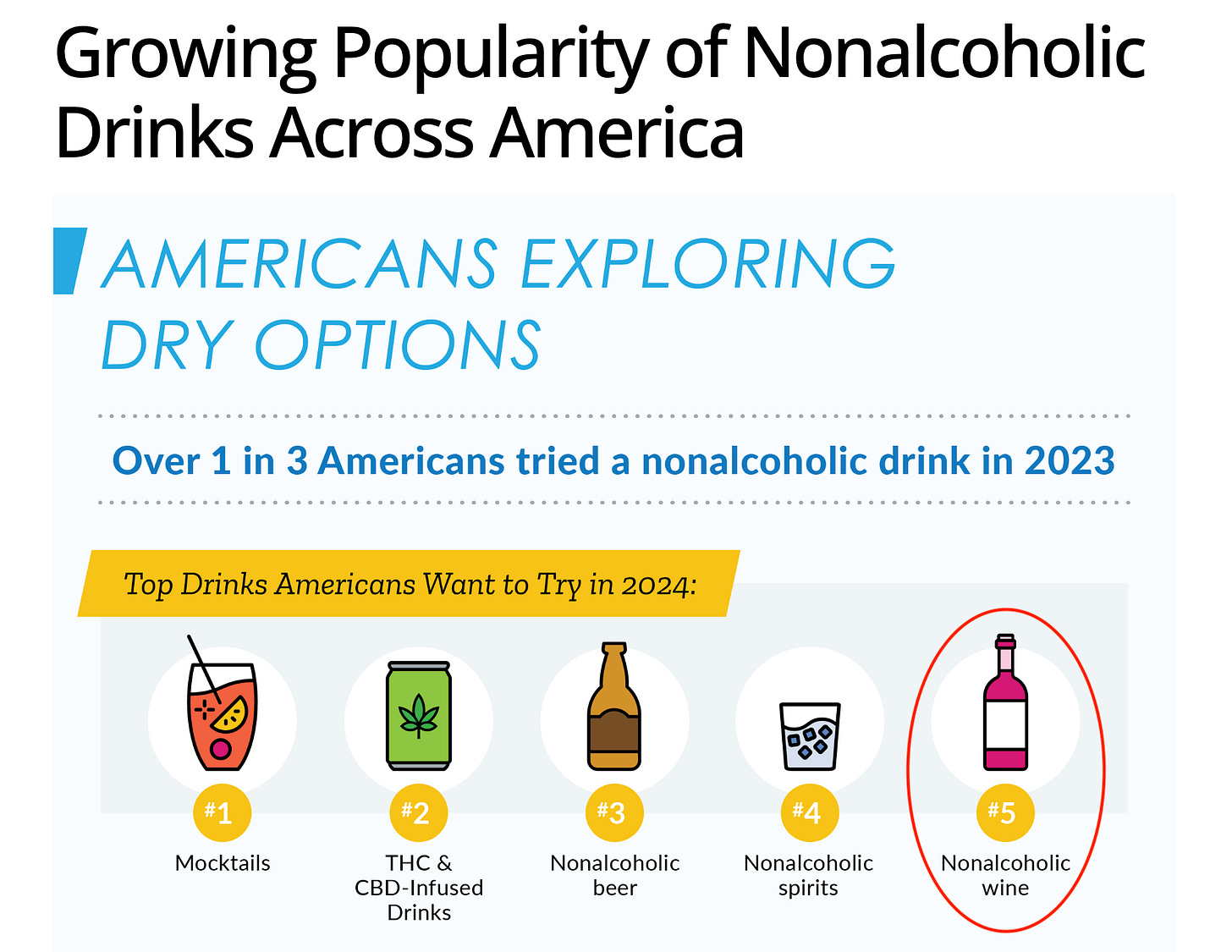
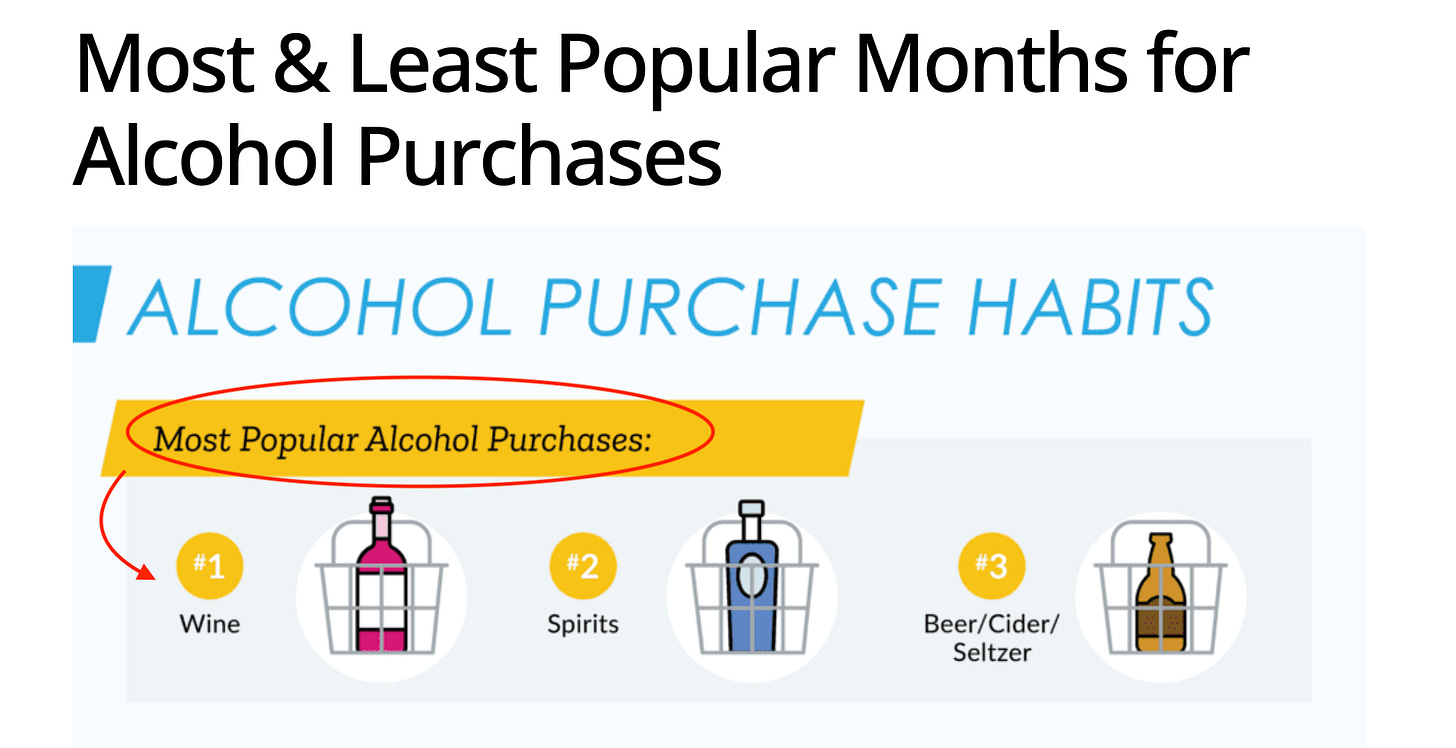



Great work Liz. This is so impactful coming from you and your expertise in the industry. It’s so refreshing to hear your perspective.
Thank you for your kind words and for such an amazing article! Great work getting to the heart of the problem and finding an equitable solution for all.